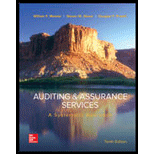
Auditing & Assurance Services: A Systematic Approach (Irwin Accounting)
10th Edition
ISBN: 9780077732509
Author: William F Messier Jr, Steven M. Glover Associate Professor, Douglas F. Prawitt Associate Professor
Publisher: McGraw-Hill Education
expand_more
expand_more
format_list_bulleted
Question
Chapter 20, Problem 20.2RQ
To determine
Concept Introduction:
Proportionate liability: proportionate liability is a presentation of the records of liability that require each member’s participation and ensure that each member attains his or her responsibility towards financial result. It enables the court to allocate the responsibility for the claim of any misreports and wrong action performs by the courts.
To explain: The proportionate liability with the doctrine of joint and several liabilities
Expert Solution & Answer
Want to see the full answer?
Check out a sample textbook solution
Students have asked these similar questions
Need answer.
Solve plz now
Precious metal qn solve .
Chapter 20 Solutions
Auditing & Assurance Services: A Systematic Approach (Irwin Accounting)
Ch. 20 - Prob. 20.1RQCh. 20 - Prob. 20.2RQCh. 20 - Prob. 20.3RQCh. 20 - Prob. 20.4RQCh. 20 - Prob. 20.5RQCh. 20 - Prob. 20.6RQCh. 20 - Prob. 20.7RQCh. 20 - Prob. 20.8RQCh. 20 - Prob. 20.9RQCh. 20 - Prob. 20.10RQ
Ch. 20 - Prob. 20.11RQCh. 20 - Prob. 20.12RQCh. 20 - Prob. 20.13RQCh. 20 - Prob. 20.14MCQCh. 20 - Prob. 20.15MCQCh. 20 - Prob. 20.16MCQCh. 20 - Prob. 20.17MCQCh. 20 - Prob. 20.18MCQCh. 20 - Prob. 20.19MCQCh. 20 - Prob. 20.20MCQCh. 20 - Prob. 20.21MCQCh. 20 - Prob. 20.22MCQCh. 20 - Prob. 20.23MCQCh. 20 - Prob. 20.24MCQCh. 20 - Prob. 20.25MCQCh. 20 - Prob. 20.26PCh. 20 - Prob. 20.27PCh. 20 - Prob. 20.28PCh. 20 - Prob. 20.29P
Knowledge Booster
Similar questions
arrow_back_ios
SEE MORE QUESTIONS
arrow_forward_ios
Recommended textbooks for you
 Intermediate Accounting: Reporting And AnalysisAccountingISBN:9781337788281Author:James M. Wahlen, Jefferson P. Jones, Donald PagachPublisher:Cengage LearningPrinciples of Accounting Volume 1AccountingISBN:9781947172685Author:OpenStaxPublisher:OpenStax College
Intermediate Accounting: Reporting And AnalysisAccountingISBN:9781337788281Author:James M. Wahlen, Jefferson P. Jones, Donald PagachPublisher:Cengage LearningPrinciples of Accounting Volume 1AccountingISBN:9781947172685Author:OpenStaxPublisher:OpenStax College Individual Income TaxesAccountingISBN:9780357109731Author:HoffmanPublisher:CENGAGE LEARNING - CONSIGNMENT
Individual Income TaxesAccountingISBN:9780357109731Author:HoffmanPublisher:CENGAGE LEARNING - CONSIGNMENT

Intermediate Accounting: Reporting And Analysis
Accounting
ISBN:9781337788281
Author:James M. Wahlen, Jefferson P. Jones, Donald Pagach
Publisher:Cengage Learning

Principles of Accounting Volume 1
Accounting
ISBN:9781947172685
Author:OpenStax
Publisher:OpenStax College


Individual Income Taxes
Accounting
ISBN:9780357109731
Author:Hoffman
Publisher:CENGAGE LEARNING - CONSIGNMENT

